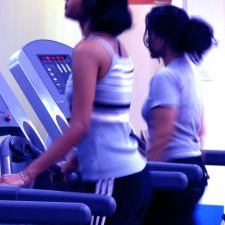Travel Tips
Tips on Healthy Eating for Business Travelers
 Business lunches, all-day meetings, catered affairs … it seems like most work-related dining is filled with diet-busting temptation. Annette Lang steps in with a few tips on healthier eating.
Business lunches, all-day meetings, catered affairs … it seems like most work-related dining is filled with diet-busting temptation. Annette Lang steps in with a few tips on healthier eating.
I’m a personal trainer and that means I get to work with some highly motivated and successful individuals—in their own spheres of influence and their own individual businesses.
When it comes to making healthy choices on the road, well, that’s where I have to step in.
I understand that we are all better at some aspects of motivation than others. Why is it easy for me, a personal trainer, to find time to exercise but difficult to be organized at work? Why is it easy for others to take the necessary steps to be successful at business, yet fall apart when it comes to eating right on the road?
To be successful at any business, you have to have a goal, and a well-designed, detailed plan to follow. Well, you need to do the same work in order to be successful with your eating habits while traveling for business.
Let’s start with goal setting. Do you have one related to your eating habits? Do you want to lose weight? Or are you happy with your weight right now and basically want to maintain it?
 Having a goal lays the foundation for preparation, and a plan for you to be successful. If you don’t have a goal, it is too easy to make poor choices. For example, if you have a martini before your work dinner, you add about 85 calories to your daily intake (assuming you have 1 ounce of gin). If you add another two glasses of wine with dinner, you add about 170 more calories (considering an average of 80 calories per 4-ounce serving).
Having a goal lays the foundation for preparation, and a plan for you to be successful. If you don’t have a goal, it is too easy to make poor choices. For example, if you have a martini before your work dinner, you add about 85 calories to your daily intake (assuming you have 1 ounce of gin). If you add another two glasses of wine with dinner, you add about 170 more calories (considering an average of 80 calories per 4-ounce serving).
If you do that a couple of days each week, don’t be surprised when you gain one pound in a few weeks. That doesn’t sound like much, but at the end of the year you could be 10 pounds heavier!
The problem is that you didn’t focus on the goal of maintaining or losing weight. If you are conscious of your goal, you can arm yourself with the appropriate information, and make a plan in order to make better choices. So, you want that martini? Fine. How about eating a little less dinner? That 8-ounce steak you order can add up to 427 calories. If you eat just a little bit less, and take the rest home, you can substitute the calories with the cocktail.
In terms of being prepared, especially for business meals, start by thinking about when you get into trouble with eating. Identifying where you get into trouble is the first step in changing your behaviors:
- When you end up dining somewhere you are not expecting
- When skip meals and end up eating whatever is in front of you at that moment
- When you drink alcohol and your inhibitions and willpower go down the drain
- When you are with people who intimidate you and your self-esteem or confidence is lowered
Think about these conditions and what you could have done better. Just as with work, you can take your past experiences and learn from them to do better the next time.
- Could you have asked about where you were going to eat, or what was being ordered in, so you were not caught off-guard?
- Could you have planned ahead so you didn’t find yourself overly hungry later? Could you have had a big glass of water or seltzer to fill up before making your food choices?
- Could you have passed on the alcohol, or slowed your pace?
- Could you see yourself making a better choice, thereby increasing your self-esteem and confidence in front of the people you found intimidating? How do you feel when you have seen others achieving the goals you’ve set for yourself?
Once you identify these patterns, think about what you could have done differently, you can begin to decide what changes make the most sense for you. Which choice can you really see yourself doing? It doesn’t mean it is going to work every time, as changing habits is very difficult and you need to accept that it might take several attempts to be successful—just like business, right?
PREPARATION IS THE KEY
- If you are going to a restaurant, go online to check out the menu. If you can decide on your healthier option ahead of time, you won’t even have to look at the menu when you get there.
- Keep the bread basket far, far away from where you’re sitting.
- If you’re attending a meeting where food is being ordered ask if you can make your own choices.
- If not, plan to bring your own sandwich. You can make choices to reduce the calories, mustard instead of mayonnaise, or picking lean meats instead of tuna salad.
- If the food you are eating is high in calories, immediately divide it in half. That other half can go to someone who really needs it, or you can throw it away later.
- If you’re handed a hefty, high-calorie sandwich, either eat one half, or use a fork and avoid the bread altogether.
- If you know you are going to eat out for lunch, stick with a low-calorie but filling breakfast in the morning, like oatmeal or a few egg whites with a sprinkling of cheese. A full stomach will prevent temptation later.
KNOW YOURSELF
 Do you see yourself making the decisions you are thinking about? If not, then modify the decision to one you are more confident you can follow through with (i.e. if you can’t avoid the peer pressure of ordering a steak lunch, at least get a side of steamed veggies instead of potatoes, and skip dessert.)
Do you see yourself making the decisions you are thinking about? If not, then modify the decision to one you are more confident you can follow through with (i.e. if you can’t avoid the peer pressure of ordering a steak lunch, at least get a side of steamed veggies instead of potatoes, and skip dessert.)
Again, think of what you go through mentally at work in order to get through the tough times. Use positive self talk—literally talking to yourself in a positive tone, telling yourself that you are going to be successful.
Visualization is also a powerful tool. Picture yourself at a business lunch or dinner, doing what you say you are going to do. If you are not successful in the execution, ask yourself why it happened. Don’t set your expectations too high, and focus on just one change at a time. Would you feel more comfortable trying a different behavior next time?
In the end, give yourself a break. Making changes related to food habits is tough, so really think through these components and you will increase your chances of success!
By Annette Lang for PeterGreenberg.com. Annette Lang is a personal trainer and the author of Morning Strength Workouts. For more information about Annette, visit her Web site at www.AnnetteLang.com.
Read more from Annette Lang on PeterGreenberg.com:












